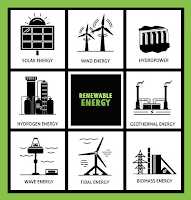Renewable energy is an emissions free source of power production that can both improve air quality and mitigate against climate change. For these and other reasons clean energy is vital to the future of life on the Earth. Interest in renewables continues to grow and this is driving a green jobs boom. Solar and wind investments have been steadily increasing, as have investments in other forms of emissions free power. While government policies are an obstacle, even the Trump administration cannot stop the market appeal associated with declining costs (including batteries). With each passing year 100% renewable energy becomes more feasible. Here is a summary of ten types of renewable energy. The first eight are easy can you guess the final two?
1. Solar energy
Solar Energy is the most accessible wellspring of energy. The primary forms of solar energy are heat and light. Photovoltaic cells (PV Cells) are the most common and they convert the sunlight directly into the electricity. This can in turn be stored in batteries for periods when the sun is not shining. Solar can take the form of massive solar arrays or small scale distributed solar power production in businesses and homes. There are also a wide range of solar innovations.
2. Wind energy
Wind power is a readily available renewable energy source. Turbines are capture the the wind’s power and convert it to electricity. The energy from the wind turns the two or three propeller-like blades around a rotor in windmill. The rotor is connected to the main shaft, and this shaft connected with the generator that creates electricity. Like solar, wind power can be stored in batteries for periods when the wind is not blowing. Wind can also take the form of massive wind installations or small scale distributed wind power production in businesses and homes.
3. Hydro power
This is one of the most abundant forms of renewable energy contributing to 10 percent of the world’s electricity generation. In hydroelectric power production the flow of water is converted into electricity by turning a turbine.
4. Hydrogen
Hydrogen is one of the most abundant elements however it does not occur naturally as a gas on earth. Hydrogen consists of one atom and one electron. Hydrogen is produced through extraction process called reforming where heat is applied for the separation of hydrogen from carbon. Hydrogen can be extracted and stored. Hydrogen is already powering “zero emission’’ vehicles and aircraft. Hydrogen may also be used for electricity generation.
5. Geothermal energy
Geothermal energy is a clean and sustainable way of harvesting the heat from the Earth. This can involve varying depths from shallow to a few miles under the surface of the earth, and magma very deep under ground. There are three main types of geothermal energy systems: Direct use district heating system, electricity generation in power plants and geothermal heat pumps. In some of these configurations steam from hot water reserves rotates a turbine, then the turbine activates a generator, which produces electricity. In another geothermal configuration a heat pump can remove heat from the heat exchanger and pump it into the air delivery system (winter) or conversely move the heat from the indoor air into the heat exchanger (summer).
6. Wave energy
This form of energy is produced when the electricity generators are placed on the surface of the ocean. The amount of energy generated is calculated by the wave height, wave speed, wavelength and the water density. Energy generated by waves can be converted into electricity through electric generators (hydraulic ram, elastomeric hose pump, and pump to shore, hydroelectric turbine, air turbine and linear electric generator). It is widely applied for the desalination purpose in power plants and water pumps.
7. Tidal energy
Tidal power or tidal energy is the form of hydropower that converts the energy obtained from tides into useful forms of power, mainly electricity. Interest in these technologies have increased due to new developments in dynamic tidal power, tidal lagoons, axial turbines, and cross flow turbines
8. Biomass energy
Biomass is defined as alive or newly dead organisms and any by-products of those organisms, plant or animal. Biomass can be used to produce renewable power, thermal energy, or transportation fuels (biofuels). It most often refers to plants or plant-based resources which are specifically called lignocellulose biomass. Biomass can either can used in combustion to produce heat, or indirectly converting it to various forms of biofuels that can be used for transportation. Animal waste can be source for biomass, so can can dead plants, trees, grass, leaves, crops or garbage.
9. Waste to energy
Waste-to-energy (WtE) or energy-from-waste (EfW) is the process of generating energy in the form of electricity and/or heat from the primary treatment of waste, or the processing of waste into a fuel source. WtE is a form of energy recovery. Waste to energy technology includes aging and esterification.
10. Graphene
Graphene has been heralded as a game changing energy solution. Graphene can be used to extract hydrogen fuel from the air and burn it as a carbon free source of energy in a fuel cell. This entails the collection and generation of emissions free electricity from the abundant hydrogen in water. Graphene also has numerous other possible applications including far more efficient solar cells, and extended life batteries that would significantly increase the range of electric vehicles and may offer a viable means of electrifying air travel.

